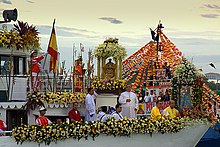The Ati-Atihan Festival is a feast held annually in January in honor of the Santo Niño (Infant Jesus), concluding on the third Sunday, in the island and town ofKalibo, Aklan in the Philippines. The name "Ati-Atihan" means "to be like Aetas" or "make believe Ati's." Aetas were the primary settlers in the islands according to history books. They too are the earliest settlers of Panay Island where the province of Aklan is situated.[1]
The festival consists of tribal dance, music, accompanied by indigenous costumes and weapons, and parade along the street. Christians, and non-Christians observe this day with religious processions. It has inspired many other Philippine Festivals including the Sinulog Festival of Cebu and Dinagyang of Iloilo, both adaptations of the Kalibo Ati-Atihan Festival.
HistoryA 13th century (c.1200 A.D.) event explains the origins of the festival. A group of 10 Malay chieftains called Datus, fleeing from the island of Borneo settled in the Philippines, and were granted settlement by the Ati people, the tribes of Panay Island. Datu Puti, Makatunaw's chief minister made a trade with the natives and bought the plains for a golden salakot, brass basins and bales of cloth. For the wife of the Ati chieftain, they gave a very long necklace. Feasting and festivities followed soon after.[2]Events

- Dinagyang of Iloilo
- Halaran of Capiz
- Binirayan of Antique
- MassKara of Bacolod
- Biniray Festival of Romblon, Romblon.
- Several nearby towns and villages of Aklan, Antique and Capiz also hold the Ati-Atihan Festival.
Some time later, the Ati people were struggling with famine as the result of a bad harvest. They were forced to descend from their mountain village into the settlement below, to seek the generosity of the people who now lived there. The Datus obliged and gave them food. In return, the Ati danced and sang for them, grateful for the gifts they had been given. [3]
The misoln was originally a pagan festival from this tribe practicing Animism, and their worshiping their anito god. Spanish missionaries gradually added a Christian meaning. Today, the Ati-Atihan is celebrated as a religious festival.
The people attend masses for the Santo Niño, and benefit dances sponsored by government organizations. The formal opening mass emphasizes the festival’s religious event. The procession begins with a rhythmic drumbeats, and dances parading along the street. The second day begins at dawn with a rosary procession, which ends with a community mass, and procession. The phrase "Hala Bira! Pwera Pasma!" is originally associated with the Sto. Nino Ati-Atihan Festival as the revelers and devotees keep on going with the festivities all over the town from morning to the wee hours of the next morning, rain or shine, for one week or even more. They believe that the miraculous Child Jesus will protect them from harm and illness. The highlight of the festival occurs on the last day, the third Sunday of January, when groups representing different tribes compete for tourists' attention and prizes. The festival ends with a procession of thousands of people carrying torches and different kinds of images of the Santo Niño. The contest winners are announced at a masquerade ball which officially ends the festival.
Other festivals held in the region include.






















